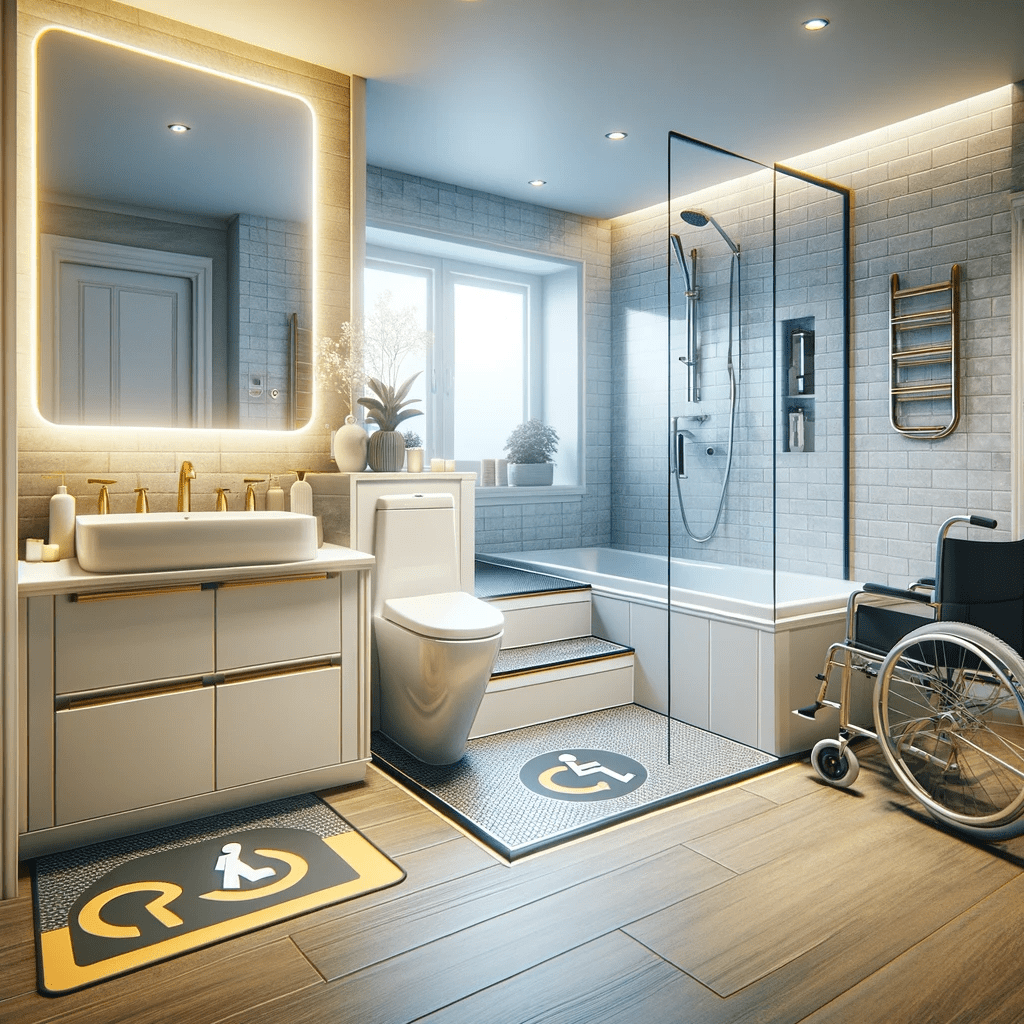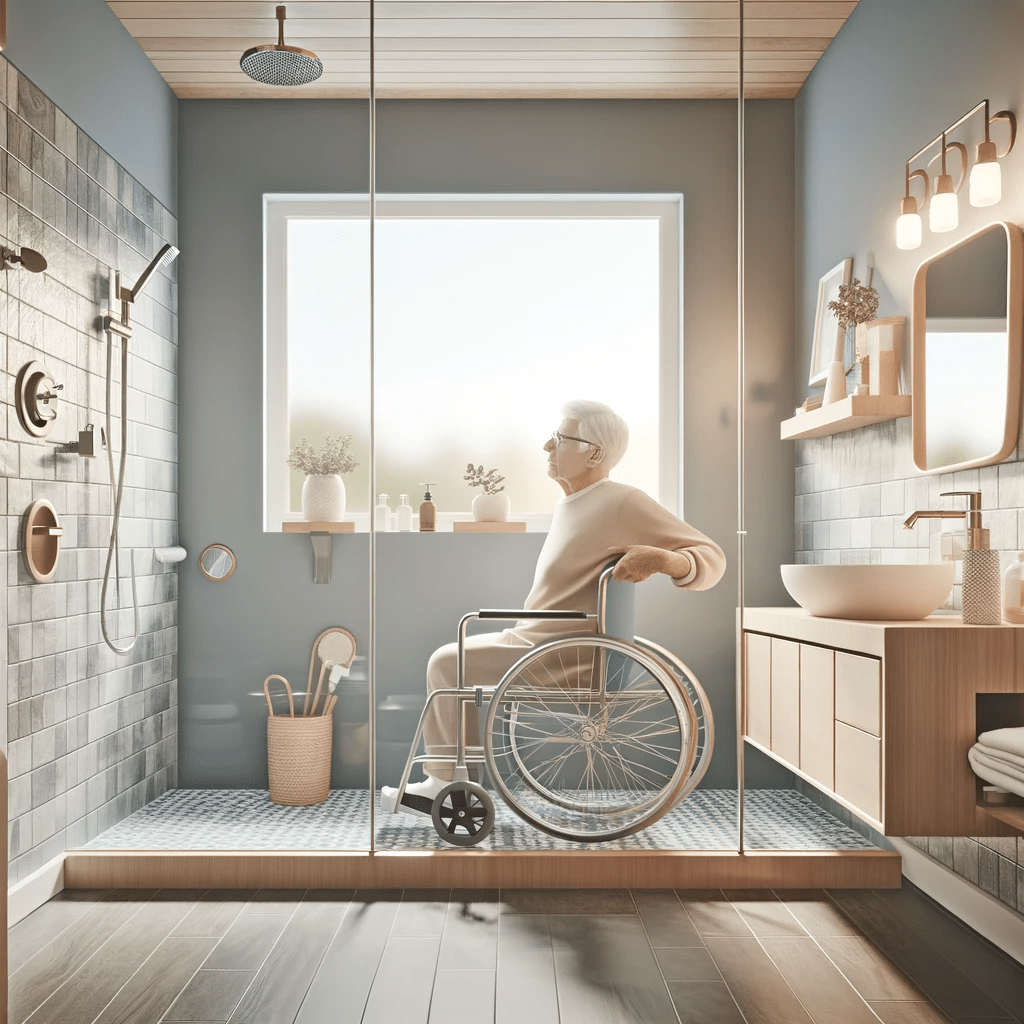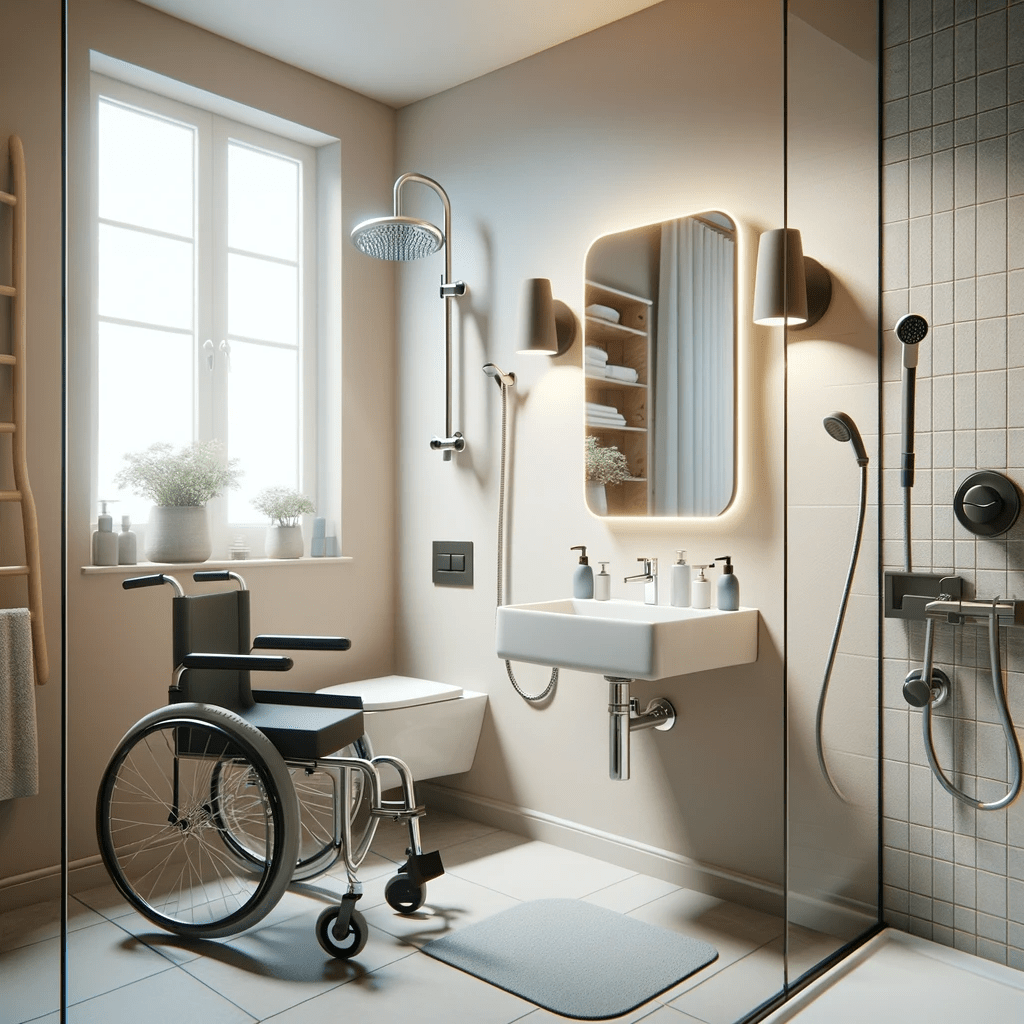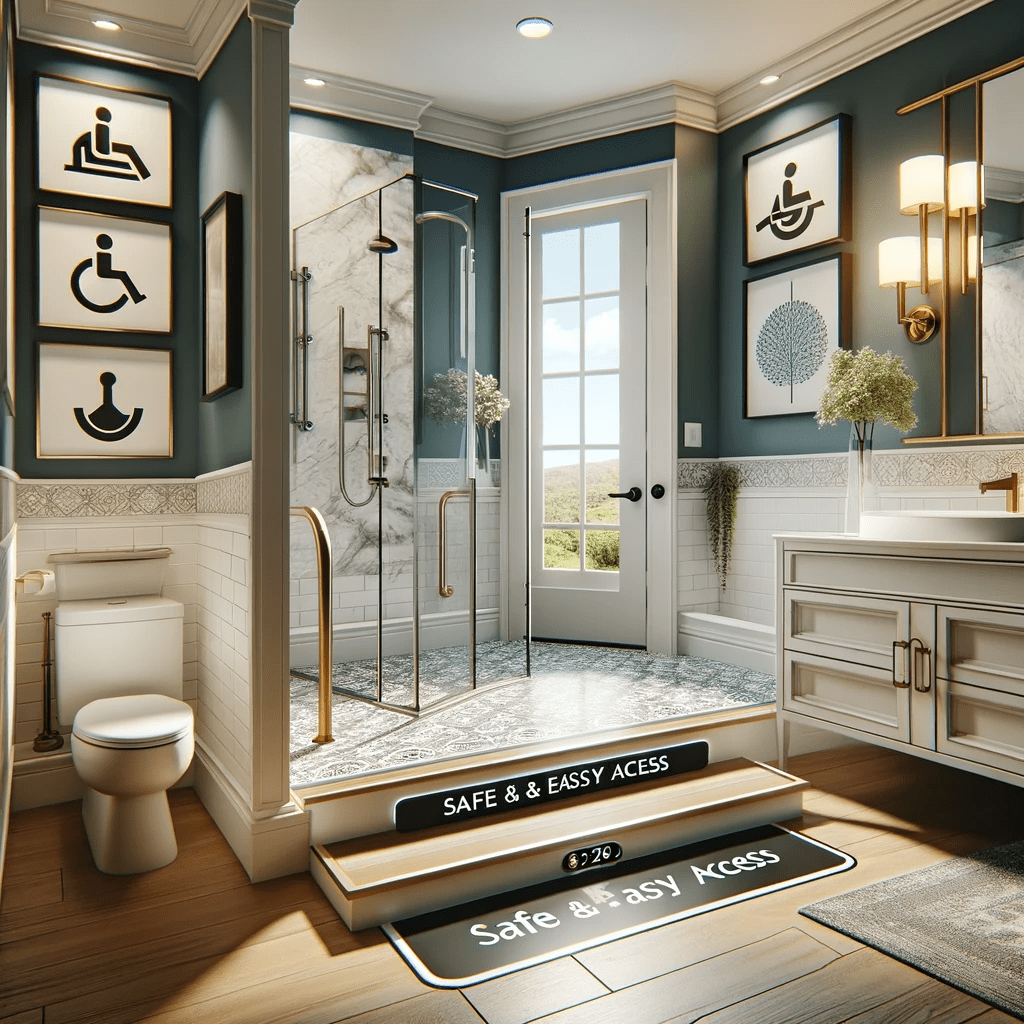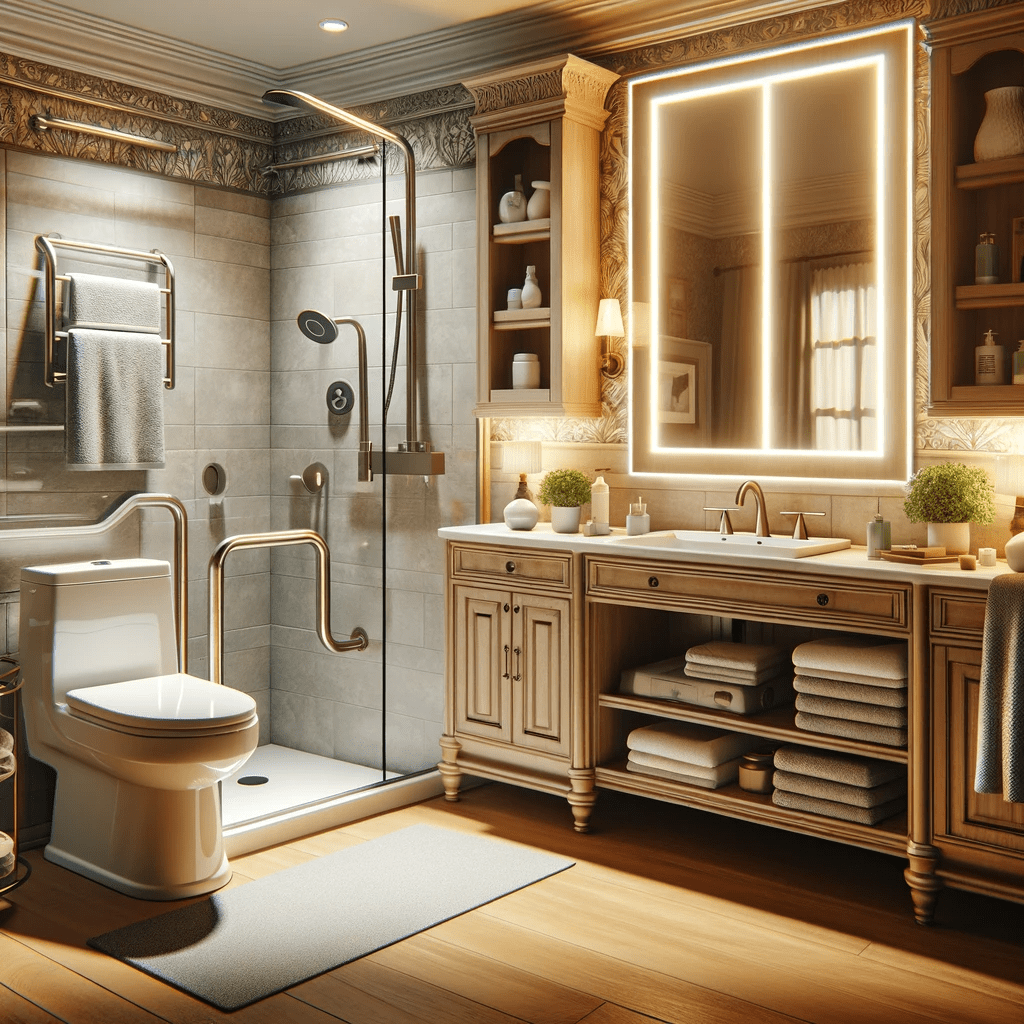As we age, our mobility and physical abilities change, making it essential to design homes that are accessible and user-friendly. One of the most important areas of the home to consider when it comes to accessibility is the bathroom. In this article, we’ll provide tips and considerations for designing an age-friendly and accessible bathroom renovation.
Plan for Accessibility
Creating an accessible bathroom is a proactive approach to accommodate individuals of all ages and abilities, ensuring comfort and safety for everyone who uses the space. When planning for an accessible bathroom remodel, it’s vital to consider the various needs that might arise due to mobility limitations or disabilities. This isn’t just about meeting current needs; it’s about anticipating future requirements and making the bathroom a versatile, welcoming space for years to come. By incorporating accessibility from the outset, you can create a bathroom that is both functional and stylish while ensuring that it adapts to the evolving needs of its users.
Key Accessibility Features:
- Widening Doorways: Ensure that doorways are wide enough to accommodate wheelchairs or walkers. Consider pocket doors or outward swinging doors for easier access.
- Height-Adjustable Fixtures: Use fixtures that can be adjusted or are set at an accessible height. This includes sinks, toilets, and shower controls that are reachable for both seated and standing users.
- Grab Bars: Install grab bars near the toilet, shower, and bathtub areas. Ensure they are securely fixed and positioned to provide support for balance and mobility.
Incorporating Universal Design Principles:
- No-Threshold Showers: Design showers without thresholds to allow easy entry and exit, reducing the risk of trips and falls. Include a handheld showerhead and a seat for added comfort and versatility.
- Slip-Resistant Flooring: Choose flooring materials that reduce the risk of slips and falls, such as textured tiles or slip-resistant vinyl. Ensure the floor surface is even and transitions smoothly between different areas.
- Clear Floor Space: Maintain ample clear floor space for manoeuvrability, especially around fixtures like the toilet and shower. This space is crucial for those using mobility aids.
Planning for Varied Abilities:
- Multi-level Countertops: Incorporate countertops at varying heights to accommodate users of different statures and those who may be seated.
- Lever Handles and Touchless Tapware: Use lever handles or touchless tapware for easy operation by people with limited hand strength or dexterity.
- Adjustable and Ample Lighting: Ensure the bathroom is well-lit with adjustable lighting options to accommodate varying visual needs. Consider motion sensor lights for easier navigation.
Building Codes and Guidelines:
- Compliance: Familiarise yourself with the guidelines or local building codes related to accessibility. Adhering to these standards ensures that the design meets the legal requirements for accessibility.
- Professional Consultation: Engage with a certified aging-in-place specialist or a designer knowledgeable in accessible design to ensure that all aspects of your remodel meet the necessary standards and best practices.
Cost Considerations and Resources:
- Budgeting for Accessibility: Factor in the cost of accessibility features as part of your overall budget. Some modifications might be more expensive initially but can save costs in the long run by preventing accidents or negating the need for future renovations.
- Seeking Financial Assistance: Look into grants, loans, or other financial assistance programs that might be available for making homes more accessible, especially for seniors or individuals with disabilities.
Planning for accessibility in a bathroom renovation is an essential step in creating a safe, comfortable, and welcoming space for all users. By incorporating thoughtful design elements and adhering to accessibility standards, you can ensure that your bathroom serves the needs of family members and guests with varying abilities. An accessible bathroom not only enhances the quality of life for its users but also adds value to your home, making it a wise investment in both the present and future.
Learn More About The Pros and Cons of Trendy vs. Timeless Bathroom Designs
Consider User Experience
Understanding User Needs
Begin by understanding who will use the bathroom and their specific needs. Recognising that 1 in 6 Australians have a disability, it’s vital to consider the range of abilities of users. As we age, the likelihood of mobility and cognitive impairments increases, making thoughtful design essential for an age-friendly bathroom.
Adhering to Australian Standards
Ensure that the layout and fixtures comply with Australian Standards (AS 1428.1-2009), which dictate the design requirements for accessible bathrooms. These include critical measurements like the 1500mm x 1500mm turning space for wheelchairs and the force tolerance for grab bars (up to 1100N). Compliance is not just about legality; it’s about ensuring safety and usability.
Discover More About Designing a Spa-Like Bathroom Retreat on a Budget
Streamlining the Flow
The overall flow of the bathroom must be intuitive and hazard-free. Incorporate non-slip flooring to mitigate the risk of falls and install lever taps for easy operation. A walk-in shower with a bench and adjustable showerhead can significantly enhance the user experience, providing both comfort and flexibility.
Focusing on Lighting and Visibility
Proper lighting is essential in an accessible bathroom, especially for the elderly. Aim for a bright, adjustable lighting setup to ensure safety and comfort. The Lighting Research Centre recommends a range of 300-500 lux for bathrooms utilised by older adults, a guideline that can significantly reduce the risk of accidents and enhance the overall bathroom experience.
Accessibility Features and Compliance Table
| Feature | Description | Australian Standard Compliance | Importance |
|---|---|---|---|
| Turning Space | Minimum space for wheelchair to turn comfortably. | 1500mm x 1500mm as per AS 1428.1-2009 | Essential for manoeuvrability. |
| Grab Bars | Bars installed near the toilet and shower areas. | Must withstand a force of up to 1100N | Critical for stability and support. |
| Non-Slip Flooring | Flooring designed to prevent slips and falls. | Material choice and installation per safety guidelines. | Reduces risk of falls, crucial for all ages. |
| Lever Taps | Taps that are easier to use than traditional knobs. | Recommended for ease of use. | Easier for people with reduced hand strength. |
| Walk-In Shower | A shower area that is easy to access. | Includes bench and hand-held showerhead options. | Enhances flexibility and comfort. |
| Lighting | Adjustable and sufficient lighting for safety and comfort. | 300-500 lux recommended for older adults. | Prevents accidents and ensures visibility. |
Read More on Small Bathroom, Big Impact: Creative Design Solutions for Limited Space
Safe and Easy Access
Prioritising Location and Access
One of the most important considerations when designing an accessible bathroom is ensuring it’s strategically located. Ideally, the bathroom should be on the main level of the home to avoid the need for stairs. If this isn’t possible, a reliable and safe stairlift should be considered as an alternative. This consideration is crucial for individuals with mobility issues or those who rely on assistive devices.
Installing Step-in Showers and Walk-in Tubs
To facilitate safe and easy entry and exit, consider the installation of step-in showers or walk-in tubs. These fixtures are designed to minimise the risk of slips and falls, which are common in standard tubs and showers. Step-in showers should have a minimal threshold and be equipped with grab bars and non-slip flooring. Walk-in tubs, with their watertight doors, offer a similar level of safety and accessibility, making bathing a safer experience.
Safe and Easy Access Features and Compliance Table
| Feature | Description | Benefit | Compliance Note |
|---|---|---|---|
| Main Level Location | Bathroom located on the ground floor or accessible level. | Eliminates the need to navigate stairs. | Ideal for mobility-impaired users. |
| Stairlift | An assistive device for safe upstairs access. | Provides a safe alternative when bathroom can’t be located on the main level. | Ensure compliance with safety standards and user’s mobility needs. |
| Step-in Shower | Shower with minimal threshold. | Reduces the risk of trips and falls. | Include non-slip flooring and grab bars for added safety. |
| Walk-in Tub | Tub with door for easy access. | Eliminates the need to step over a high threshold. | Ensure it’s equipped with non-slip floors and seating for safety. |
Find Out About The Benefits of an Open-Concept Bathroom Design
Comfort and Convenience
Enhancing Lighting for Comfort and Safety
Adequate lighting is a cornerstone of comfort and safety in any age-friendly bathroom design. Proper lighting can significantly reduce the risk of falls and ensure that users can see clearly, minimising strain. Consider a mix of overhead and task lighting that’s bright enough to illuminate the entire space but can be adjusted for comfort.
Ensuring Flooring Safety and Stability
Non-slip flooring is essential to prevent slips and falls, a common risk in bathrooms for individuals of all ages, but particularly for the elderly. Options like textured tiles, rubber flooring, or low-pile carpeting can provide the necessary grip and stability. Ensure that the flooring choice meets the slip resistance standards and is easy to clean and maintain.
Providing Support with Grab Bars
Install grab bars near the toilet, shower, and tub areas to provide support and stability. These are vital for individuals who need extra help moving around or maintaining balance. The bars should be strategically placed where they are most needed and should be able to support the user’s weight. Choosing grab bars that complement the bathroom’s aesthetic can also enhance the overall design.
Comfort and Convenience Features and Compliance Table
| Feature | Description | Benefit | Compliance Note |
|---|---|---|---|
| Adequate Lighting | Bright, adjustable lighting in the bathroom. | Reduces risk of accidents and enhances visibility. | Consider a range of 300-500 lux for elderly users. |
| Non-Slip Flooring | Flooring designed to prevent slips and falls. | Essential for maintaining balance and stability. | Choose materials that meet slip-resistance standards. |
| Grab Bars | Bars near the toilet, shower, and tub for support. | Provide stability and support for users. | Install according to user’s height and strength needs and ensure they withstand necessary force. |
Dive Into Tips for Maximizing Natural Light in Your Bathroom Remodel
Essential Fixtures and Fittings
Choosing User-Friendly Fixtures
When selecting fixtures for an accessible bathroom, prioritise comfort and ease of use. The toilet, sink, and shower should accommodate the user’s needs, focusing on functionality and accessibility. For instance, lever faucets are easier for individuals with limited hand strength, and height-adjustable sinks can benefit users of various statures and those in wheelchairs.
Installing Elevated Toilet Seats
An elevated toilet seat can significantly aid those with mobility issues. It reduces the effort required to sit down and stand up, a crucial aspect for individuals with limited strength or balance. Ensure the height is appropriate for the user and consider models with integrated grab bars for additional support.
Incorporating Walk-In Showers with Handheld Showerheads
A walk-in shower with a handheld showerhead offers flexibility and ease of use. It eliminates the barrier of traditional tubs and allows users to shower comfortably while seated if necessary. The handheld showerhead can be positioned as needed, making it an excellent choice for users with limited mobility or those who need to remain seated.
Essential Fixtures and Fittings Features and Compliance Table
| Feature | Description | Benefit | Compliance Note |
|---|---|---|---|
| User-Friendly Fixtures | Fixtures that prioritise ease of use and functionality. | Enhances the user’s independence and comfort. | Choose fixtures that meet accessibility standards and user needs. |
| Elevated Toilet Seat | Toilet seat that is higher than standard. | Makes sitting down and standing up easier. | Ensure it’s the right height and offers stability. |
| Walk-In Shower with Handheld Showerhead | Shower that’s easy to enter with a flexible showerhead. | Provides a safer, more adaptable shower experience. | Install with minimal threshold and include adjustable features. |
Uncover Details on How to Choose the Right Colour Scheme for Your Bathroom Renovation
Designing an age-friendly and accessible bathroom renovation is essential for maintaining independence and quality of life as we age. When designing an accessible bathroom, plan ahead, consider user experience, ensure safe and easy access, prioritise comfort and convenience, and choose essential fixtures and fittings that are functional and user-friendly. Always consult with a licensed contractor or accessibility specialist before embarking on any home improvement project.


